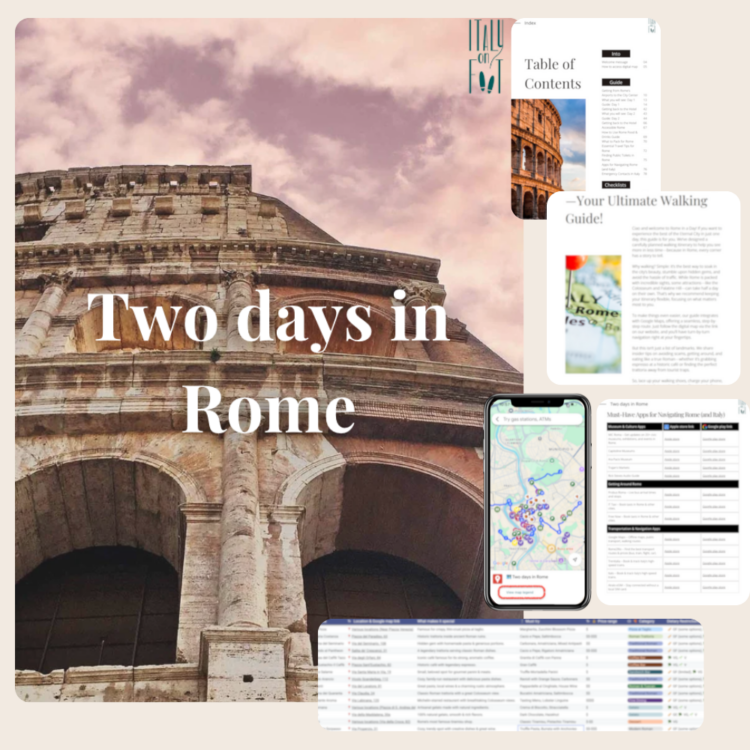Navigating the intricacies of traveling to Europe, especially Italy, can be a rewarding adventure. Whether you’re planning a culinary escapade through Tuscany, an exploration of ancient ruins in Rome, or an art-filled visit to Florence, there are essential steps one must follow to ensure a smooth journey. One of the most crucial of these steps is understanding the travel requirements, particularly when it comes to a Travel Visa for Italy & EU. Starting in mid-2025, new regulations will mandate that visitors from many visa-exempt countries obtain an ETIAS (European Travel Information and Authorisation System) travel authorisation to enter 30 European nations, including Italy.
Before diving into ETIAS, make sure you have your itinerary thoughtfully planned out. For many, using walking maps of Italy is a great way to ensure you experience the most iconic and locals’ favorite spots at your pace. It’s not just about visiting tourist traps but truly experiencing the essence of Italy through its winding pathways and lesser-known nooks.
What is ETIAS and Why Do You Need It?
ETIAS is designed to enhance security and streamline the entry process for travelers from approximately 60 visa-exempt countries. From the first half of 2025, anyone who wishes to enjoy a short stay in Italy or other European countries must have an approved ETIAS travel authorisation. The aim is to assess whether travelers pose any risks before they even arrive in Europe. This system is similar to the ESTA visa waiver program used by the United States.
While applying for ETIAS is relatively straightforward, it does require that you plan ahead. The application can be filled out online through the ETIAS website or mobile app, and it requires information such as your name, travel document details, education and occupation, intended travel plans, and history of past travel. The fee is nominal, standing at EUR 7, and the application process usually takes mere minutes for most applicants. However, it’s advisable to apply well before purchasing tickets for your trip, as processing times can extend up to 30 days if additional data or documentation is needed.
The ETIAS travel authorisation will be valid for up to three years, or until your passport expires, whichever comes first. This means you won’t have to reapply for each trip, provided your travels fall within the authorisation’s validity period. With your ETIAS, you can travel freely across all participating European countries for up to 90 days within any 180-day period.
Planning Your Travel Wisely
One cannot stress enough the importance of meticulous planning. Start by gathering essential documents—especially your passport, which must be valid for at least three months after your planned departure date from Europe. Check if your passport needs renewal to avoid any hassles. For specific travel plans within Italy, it’s worth investing time into resources like self-guided walking tour of Italy. This not only offers flexibility but also ensures that you don’t miss out on hidden gems.
Once you have your ETIAS approval, guard it zealously. Double-check that the details on your ETIAS match those on your passport. This precaution will save you from being denied boarding or entry at European borders. Remember, having an approved ETIAS does not guarantee entry, as final admission depends on border guards’ discretion, who may ask additional questions or request supporting documents.
Post-ETIAS Arrival Protocols
Once you’ve arrived in Italy, make sure you adhere to local laws and respect cultural norms. Italy is known for its vibrant street life and hospitable people, but there are rules to follow. Always carry your travel documents and be prepared to present your ETIAS authorisation if required. The border inspection process remains stringent, and officials can still refuse entry if they feel conditions of entry haven’t been met.
Understanding that ETIAS is not a visa is crucial. It does not permit long-term stays or employment. If you plan to study or seek employment in Italy or the EU, separate documentation will be required.
FAQ: Acquiring a Travel Visa for Italy & EU: All About ETIAS
What is ETIAS?
ETIAS (European Travel Information and Authorisation System) is a travel authorisation requirement for nationals from visa-exempt countries who plan to visit 30 European countries, including Italy, from mid-2025 onwards. This system aims to enhance border security by pre-screening travelers before they arrive.
Do I need an ETIAS to travel to Italy?
If you are from one of the approximately 60 visa-exempt countries and intend to visit Italy or any of the other European countries that require ETIAS for a short stay (up to 90 days in any 180-day period), you will need to obtain an ETIAS before your trip.
How do I apply for ETIAS?
You can apply for ETIAS through the official ETIAS website or mobile app. The application process involves filling out a form with personal details, travel document information, and your intended travel plans. The process is typically quick, but it can take up to 30 days if additional information is required.
What are the costs associated with ETIAS?
The fee for acquiring an ETIAS travel authorisation is EUR 7. However, travelers who are under 18 or above 70 years old, or who are family members of EU citizens, may be exempt from this fee.
How long is the ETIAS valid?
The ETIAS travel authorisation is valid for three years or until your passport expires, whichever comes first. This means you can travel multiple times within this period without needing to apply for a new authorisation, as long as you respect the 90 days in any 180-day period rule.
Does an ETIAS guarantee entry into Italy?
No, having an ETIAS does not guarantee entry. While it allows you to board your flight, bus, or ferry to Italy, final entry is determined by border guards upon your arrival. They will verify compliance with entry conditions and may request additional documents.
What if there is a mistake on my ETIAS application?
Accuracy is crucial. If you realise you made a mistake after submitting your ETIAS application, the quickest way to correct it is to apply for a new ETIAS with the correct information. Minor errors may be corrected by submitting a request, but this can take up to 30 days.
Can I travel without an ETIAS if it’s my first time going to Europe after the transitional period?
During the transitional period after ETIAS is introduced, travelers should apply for ETIAS, but might not be refused entry if they meet all other entry conditions. Once the grace period ends, an ETIAS will be mandatory for all eligible travelers except those entering Europe for the first time post-transitional period.
What happens if my ETIAS is revoked or annulled while I’m in Europe?
If your ETIAS is revoked or annulled while you are in Europe, you will receive an email notification. This means you no longer meet the conditions for legal stay and must leave. Depending on the reason for annulment, you may need to apply for a new ETIAS with updated information.
When should I apply for ETIAS?
It is advisable to apply for ETIAS well before purchasing travel tickets or booking accommodation. Although most applications are processed within minutes, some may require further checks and can take up to 30 days.
Can I travel with an ETIAS for long-term stays or work?
No, ETIAS only authorises short-term stays. For long-term stays, study, or work in Italy or other European countries, you will need to apply for a specific visa relevant to your purpose of stay.
In essence, acquiring a Travel Visa for Italy & EU via the ETIAS is a critical step for travelers from visa-exempt countries. This preparation will allow you to focus on the joys of travel—like savoring that perfect gelato or wandering through ancient olive groves—without unnecessary stress. Enjoy your adventure in Italy thoroughly, where every street, piazza, and vista awaits your discovery.



